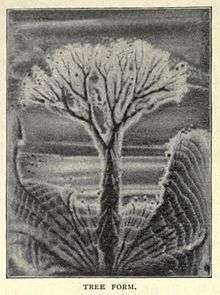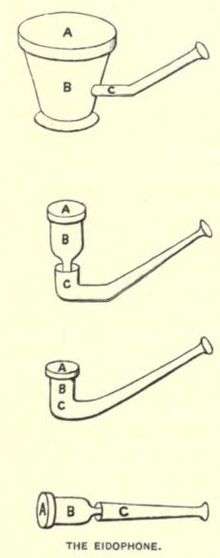Megan Watts Hughes

Megan Watts Hughes (12 February 1842 – 29 October 1907) was a Welsh singer, songwriter, scientist and philanthropist. She is also known for being the first to observe the phenomenon of "Voice-Figures", while experimenting with a device she called an "eidophone".[2] This device enabled the vibrations of sound to be visualised and she demonstrated this to the Royal Society.
Early life and musical career
She was born Margaret Watts in Dowlais, to parents who had relocated from Pembrokeshire; her father supervised the local cemetery. Following early success as a singer on the South Wales concert circuit, she obtained singing lessons from two leading Cardiff musicians, and in 1864 began studies at the Royal Academy of Music in London, where her teachers included Manuel García. However, she was forced to abandon her studies by ill-health. After marrying Hugh Lloyd Hughes in 1871, she became known as Mrs Watts Hughes and continued her musical career under that name. A deeply religious woman, she thought of Bethania Chapel as her spiritual home.[3] At Mountford House in Barnsbury Square, Islington, she founded a "Home for Little Boys".[4]
In a newspaper article of 1898, composer Joseph Parry referred to Megan Watts Hughes as being one of "our greatest vocalists".[5] She had accompanied Parry on a "musical tour" of North Wales after leaving the Royal Academy of Music, and once appeared with Jenny Lind, one of the greatest sopranos of the day (who had also been trained by García). Lind is supposed to have said of her: "I have never met anyone so related to me in the art of music. Two sisters only have I in the art-Madame Schumann and Mrs. Megan Watts-Hughes."[3] Mrs Watts Hughes wrote the hymn-tune "Wilton Square" and a number of other songs.[6]
"Voice-figures"

In 1885, while exercising her voice, she accidentally discovered what she called "voice-figures" or "voice-flowers", patterns created by the natural phenomenon of standing-wave resonance. She described the process by which she used "a thin layer of liquid" on the disc of the eidophone to assess whether the voice is singing the note "too forcibly", and found that liquids such as coloered glycerine produced intricate, flower-like patterns in the liquid.[7] In this she was unknowingly elaborating on research begun by Ernst Chladni, who used powder rather than liquid to make the patterns. She later demonstrated these at a meeting of the Royal Society.[2] She wrote a scientific paper in 1891[1] and she also wrote a short book on the subject entitled The Eidophone Voice Figures: Geometrical and Natural Forms Produced by Vibrations of the Human Voice, published in 1904.[8]
References
- 1 2 3 Visible Sound - Voice Figures, Margaret Watts Hughes, Century Magazine, Vol 42, 37 (1891)
- 1 2 Griffith, Robert David. "Megan Watts Hughes". Dictionary of Welsh Biography. National Library of Wales. Retrieved 6 April 2016.
- 1 2 "The Watts-Hughes Voice Figures. The Merthyr Express". Welsh Newspapers Online. National Library of Wales. 9 April 1910. Retrieved 7 April 2016.
- ↑ "VOICE-FIGURES". The Spectator Archive. The Spectator. 29 August 1891. Retrieved 7 April 2016.
- ↑ Parry, Joseph. "From Doctor Joseph Parry". Google Newspapers. Deseret Evening News, July 13, 1898. Retrieved 6 April 2016.
- ↑ Humphreys, Maggie. Dictionary of Composers for the Church in Great Britain and Ireland. London: Mansell. ISBN 0720123305.
- ↑ Watts Hughes, Margaret (2013). "VISIBLE SOUND – VOICE-FIGURES. Century Magazine 42, 37 (1891)". The Net Advance of Physics RETRO: Weblog. Retrieved 6 April 2016.
- ↑ The Eidophone Voice Figures: Geometrical and Natural Forms Produced by Vibrations of the Human Voice, 1904,"Christian Herald" Company, Limited.
External links
| Wikimedia Commons has media related to Eidophone experiments. |